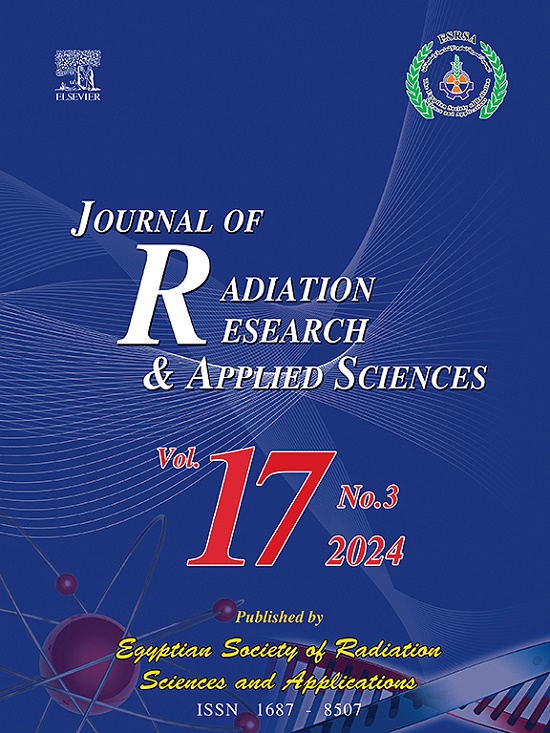非牛顿拉宾诺维奇流体通过具有多种不同形状狭窄的可渗透动脉的热辐射流动
IF 1.7
4区 综合性期刊
Q2 MULTIDISCIPLINARY SCIENCES
Journal of Radiation Research and Applied Sciences
Pub Date : 2025-03-06
DOI:10.1016/j.jrras.2025.101400
引用次数: 0
摘要
心血管疾病仍然是世界范围内死亡的主要原因之一,动脉狭窄在损害血液循环中起着至关重要的作用。可渗透动脉不均匀狭窄的存在可显著改变血流动力学,影响氧运输并增加严重并发症的风险。了解热辐射、粘性耗散和流动约束之间复杂的相互作用对于制定有效的诊断和治疗策略至关重要。本文研究了热辐射和粘性耗散对Rabinowitsch流体模型的影响,以解释滑移约束下非均匀倾斜狭窄渗透动脉中血液的剪切变薄性质。本研究旨在通过引入钟形、w形和椭圆形的多种狭窄几何形状来弥补现有模型的不足,从而提供更全面的动脉流动行为分析。控制方程在轻度狭窄假设下以无因次形式表示并解析求解。计算结果表明,布林克曼数显著影响流体温度,增强了不同动脉区域的耗散效应。然而,滑移条件和达西数的存在改变了这一趋势,特别是在动脉壁附近。狭窄高度对流动动力学的影响最小,滑移参数对速度分布的影响最大。这项研究的发现具有重要的生物医学意义,特别是在优化支架设计,改善病变动脉的血流模拟,以及加强药物靶向传递和血流动力学调节等医疗干预方面。研究结果为动脉力学的计算流体力学(CFD)和实验研究提供了理论基础,有助于疾病的早期诊断和预防策略。本文章由计算机程序翻译,如有差异,请以英文原文为准。
Thermally radiative flow of non-Newtonian Rabinowitsch fluid through a permeable artery with multiple stenoses of varying shapes
Cardiovascular diseases remain one of the leading causes of mortality worldwide, with arterial stenosis playing a crucial role in impairing blood circulation. The presence of non-uniform stenoses in permeable arteries can significantly alter hemodynamics, impacting oxygen transport and increasing the risk of severe complications. Understanding the intricate interplay between thermal radiation, viscous dissipation, and flow constraints is essential for developing effective diagnostic and therapeutic strategies. This study investigates the influence of thermal radiation and viscous dissipation on the Rabinowitsch fluid model to account for the shear-thinning nature of blood in non-uniform inclined stenosed permeable arteries under slip constraints. The research aims to bridge the gap in existing models by incorporating multiple stenosis geometries bell-shaped, W-shaped, and elliptical to provide a more comprehensive analysis of arterial flow behavior. The governing equations are formulated in dimensionless form under mild stenosis assumptions and analytically solved. Computational results reveal that the Brinkman number significantly affects fluid temperature, enhancing dissipation effects across different arterial regions. However, the presence of slip conditions and Darcy number alter this trend, particularly near the arterial walls. The stenosis height exhibits minimal influence on flow dynamics, while the slip parameter plays a dominant role in modifying velocity distributions. The findings of this study have significant biomedical implications, particularly in optimizing stent designs, improving blood flow simulations in diseased arteries, and enhancing medical interventions such as targeted drug delivery and hemodynamic regulation. The results also provide a theoretical foundation for future computational fluid dynamics (CFD) and experimental studies in arterial mechanics, aiding in early disease diagnosis and prevention strategies.
求助全文
通过发布文献求助,成功后即可免费获取论文全文。
去求助
来源期刊

Journal of Radiation Research and Applied Sciences
MULTIDISCIPLINARY SCIENCES-
自引率
5.90%
发文量
130
审稿时长
16 weeks
期刊介绍:
Journal of Radiation Research and Applied Sciences provides a high quality medium for the publication of substantial, original and scientific and technological papers on the development and applications of nuclear, radiation and isotopes in biology, medicine, drugs, biochemistry, microbiology, agriculture, entomology, food technology, chemistry, physics, solid states, engineering, environmental and applied sciences.
 求助内容:
求助内容: 应助结果提醒方式:
应助结果提醒方式:


